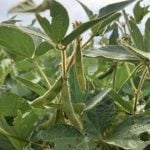BALZAC, Alta. – Long rows of heavy-podded, lush canola plants grow toward the horizon on this farm near Balzac.
They are part of an experiment that is studying the effects of a seed treatment on oats, wheat, barley, corn and canola. The treatment, which improves photosynthesis and results in more lush growth and higher yields, is part of a 25 year research project by Calgary scientists Tayyeba Mirza and Hans Johansen.
Both are interested in the science of nitrogen fixation and photosynthesis and started experimenting on a treatment to encourage plants to take advantage of those traits to grow better and ultimately produce more food.
Read Also

VIDEO: Green Lightning and Nytro Ag win sustainability innovation award
Nytro Ag Corp and Green Lightning recieved an innovation award at Ag in Motion 2025 for the Green Lightning Nitrogen Machine, which converts atmospheric nitrogen into a plant-usable form.
Once the formulation was perfected, they noted year by year improvements in their plot work, finding yield increases of 20 to 25 percent depending on the crop variety.
“Our initial study was to find the chemical which can alter the gene for photosynthesis,” Mirza said.
“If the plant can photosynthesize at lower light intensity, then it will start the photosynthesis process early in the morning when light intensity is not that much,” she said.
Some seed batches were treated six months ago and others were sprayed the day before planting to assess results.
“Right now we are at the stage where we can make the chemical easy to apply,” she said.
Inclement weather this spring prevented this year’s trial crops from being seeded before May 29, but the plants quickly recovered and grew vigorously. The researchers grow the crops under normal agronomic conditions, use common prairie varieties and measure them after harvest for yield and oil production.
Four varieties of wheat, barley, oats and canola were planted in the plots on their farm on Calgary’s northeastern limits. Untreated plots were planted for comparison.
All the plants are thick stemmed and stand upright with heavy pod development on the canola and large heads on the cereals. There was no lodging present. The cereal crops produced more stems and leaves with little sign of disease. Metcalfe barley heads had up to 30 kernels each compared to the average of 25.
Treated canola bloomed a week earlier, which in the cool and unpredictable climate around Calgary is a bonus to avoid early frost damage.
Depending on the variety, canola has an average oil content of 43 percent.
“Sprayed with the material, it will reach 48 to 50 percent,” Johansen said.
He wants to move the private project to the next stage by asking volunteer farmers to spray the treatment on their crops next year. After that he wants to work with a grain company to distribute treated seed.
The research is connected to work Johansen started to grow better grass for golf courses. Those on the links wanted lush grass that greened up sooner in the spring and stayed healthy for a longer golfing season. When that work succeeded, he decided to include agriculture.
The first projects involved hot house crops such as cucumbers and tomatoes. The formulation, which he does not reveal, worked well but he considered the market too small so decided to work on common prairie crops.
His full-time job is running the Professional Gardener Co., a wholesaler to greenhouses and the horticulture industry in Western Canada. To develop new plant products he formed Bio-Tech Environment Research Corp.















